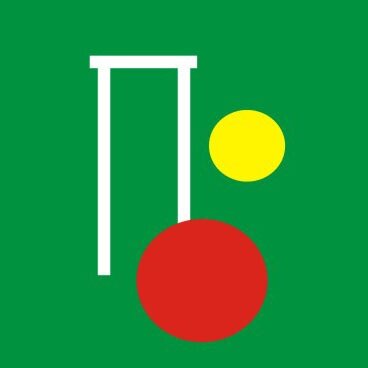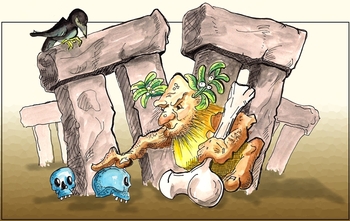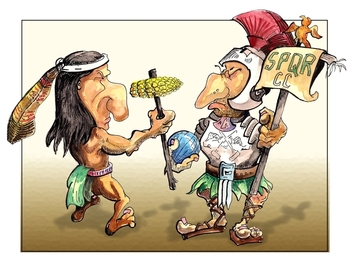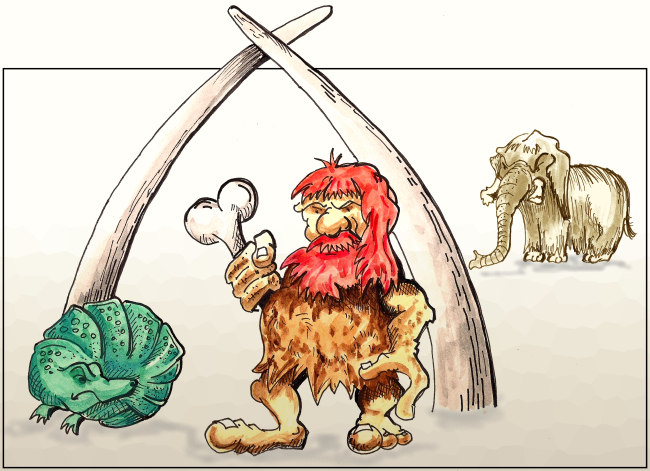
John Blamire submitted this satirical piece for the USCA's Croquet News magazine this past fall. As space has become increasingly tight in each issue, this turned out to be too long to make the cut. After an apology, I offered to post the piece on Croquet Network and John agreed. Enjoy -- Dylan Goodwin
Excerpts from the Unofficial History of Croquet
Part One: The Early Years
by - John “the Professor” Blamire
Before Dawn.
Croquet was a popular sport long before the dawn of recorded history which makes its origins hard to find and interpret. However the discovery of mammoth tusks arranged in the form of hoops or wickets starting at the time of the Cromagnons in the Pathetolitic era gives us our first clue as to when the game first started and how it got its name. “Magnon” means "player" and “Cro” means "the game", so Cromagnons were "players of the game" and they took it very seriously.
Armadillos were used instead of balls. When an armadillo was scared by an approaching player it curled up into a tight ball, just right for a long roquet. Biologists have often wondered about the sudden extinction of the Great Green armadillo at about this time. Now, the history of croquet can give them an answer. The Great Green armadillo was slightly larger than the yellow or black armadillo and kept getting stuck in the wicket, so it died out and vanished as a species.
In human evolution croquet played an enormous role. Those branches of the human tree that could use the Solomon or Irish grip had a natural advantage in the race to the championship, so the evolution of opposable thumbs was favored. Thus, humans with opposable thumbs not only won at croquet, they went on to invent fire, the wheel, writing and the internet. As a species we would not have been where we are today without in the influence of croquet on our evolution.
The oldest croquet lawn still in existence is in England at Stonehenge. Although it is now believed that the Druids did not really bring croquet to the ancient world, they did perfect an early version of the game in which skulls painted with blue woad replaced plain white skulls, thus bringing color into the game for the first time.
Croquet proved so popular that wars were fought between opposing teams for the right to go first. These battles only stopped after one enterprising croquet player whose name has long been forgotten, invented the "coin" and began to toss it. Money, therefore was invented as a way to start croquet games peacefully. Economists still dispute this analysis, but it is well known that they are rarely right about anything to do with money, and only partially understand credit cards in alternate leap-years.
The megaliths at Stonehenge are not religious in nature, as was once believed. Crowds of spectators and supporters would often destroy the lawn and wickets when their priests lost a game, so it became necessary to construct those famous, indestructible structures that are still part of the English landscape. Unfortunately, with improved diet, the skulls used in the game got wider and food left stuck between the teeth prevented the scoring of wickets, to the detriment of the game. No one knows where the term “stuck in the jaws” came from.
Because of the immense labor involved, it took about a thousand years to reset the wickets after they became too tight. By then humans had invented fire, the wheel, writing and metal wickets, so Stonehenge could be recycled for religious use and as a tool to find the sun at the vernal equinox - an obsession of many early Druids.
Julius Caesar was a croquet fanatic (“et tu Croquet” were his last words - Shakespeare got it wrong, which he often did when writing about history). Before his unfortunate death from a surfeit of daggers, Caesar sent out armies and ships to conquer the world, spread the knowledge of his favorite game among the less fortunate and thus proved his superiority. The first Roman vessel to reach America (which had not been invented yet) landed at the very tip of Long Island where the voyagers thought that they had discovered Florida. The natives were very suntanned, wore lots of sunblock, lived in giant “tea-peas” and had recently travelled in a primitive form of shaky transportation called a “jittery” after migrating north for the summer croquet season.
Eventually Centurion Gaius Osbornartus Magnus found Manhattan and purchased part of the island from a band of wandering tourists. In traditional Roman fashion he renamed it Parcus Centralis and began cutting down trees to make mallets, wickets and a sheep meadow. This became the site of the first game of "Cro-Magnus" ever played in the new world. His opponents were the Utes, the Putes and the Quetshamanuptillnows who turned out to be very good players, and who, after winning six tournaments without a loss, insisted on renaming the game after themselves - “Cro-Quetshamanuptillnow”. Unfortunately waterproof paint had not been invented yet so part of the sign over Parcus Centralis got washed away in a rain storm and the name of the game got shortened to “Cro-Quet”, which it has remained until this day.
Local mallets were made of corncobs and the losing team had to boil theirs and eat them. Bits of the softened mallet would get stuck between their teeth and some historians believe that the term “stuck in the jaws” started here. Sadly the Roman influence on the game and America was slight and did not last long. Centurion Gaius Orsbornartus Magnus became disgusted with the way the opposing tribes scalped tournament tickets, it being a local custom not yet completely solved, and he got back in his ship and sailed off in search of Australia (which had not been invented yet) and the start of another major croquet dynasty.
Go West.
Daniel P Honeyslice, known as "Old Possum", is famous as an archetypal American explorer, trader, hunter, trapper, preacher, showman, hero (until killing buffalo was considered not to be a good thing), villain (after PETA and the green movement) and for wearing dead possum skins instead of hats. He also took the first box of croquet supplies out of Parcus Centralis (renamed Park Central after the revolution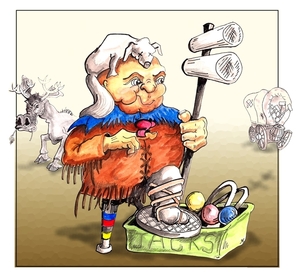 and a change in Dependence), left the original thirteen colonies, trekked across raging rivers and waded through desert sands to bring enlightenment to those who had never seen a well executed split shot.
and a change in Dependence), left the original thirteen colonies, trekked across raging rivers and waded through desert sands to bring enlightenment to those who had never seen a well executed split shot.
His standing as one of the all time great American croquet players has never been equalled. One legend is, that Old Possum was once leading a party to the famous tournament in Utah when they became trapped in a snowstorm at the top of the Rocky Mountains. To keep his companions from eating their legs, Old Possum hit such a perfect whiteout shot that the ball did not stop rolling downhill until it reached California - a new State that had not yet been discovered, despite the Spanish belief to the contrary - and so he was able to lead the remains of first flight out of danger. It is not known what happened to the second flight but it is believed that they eventually escaped, got lost, and became the famous band of ever-wandering croquet players in search of a game.
One of Daniel’s many contributions to the sport of croquet was his skill at inventing new mallets. Not content with the plain, wooden, pre-Roman tools found in every box of back-yard supplies, he constantly innovated new materials and techniques. Most of these are now in museums, including the not-so-successful jello-model and the ever famous double-headed mallet that won him 427 tournaments against less well-equipped opponents.
He will ever be remembered. He pioneered the first ball.
